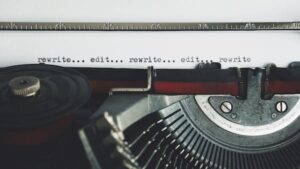Blog
Jan 25, 2023
I have been involved in proposals for nearly three decades. This depth of experience provides me with three key lessons on how to best support efforts from my role as an editor.
Lesson 1: It pays off in spades to assemble a well-rounded proposal team and not skip important steps.
Is your proposal team suited up with the right people? Are you not only proposing the right people in your actual proposal and demonstrating their qualifications but also engaging a proposal team that nails an understanding of the work and the level of effort needed?
Successful bids bring together the right mix of people with contract and program management and subject matter expertise who can evaluate whether the proposal “answers the mail.” You need the bench strength to gauge how well your company tells its story and puts its best foot forward. The combined expertise is critical to producing major, complex proposals where the competition is cut-throat. Given that proposals have a million moving parts, an experienced proposal manager is also vital to orchestrating all of the steps and problem solving when inevitable curveballs are thrown in the path. Your writers, editors, graphic designers, and production team play important roles in developing the content and creating the polished product. A great proposal team really is greater than the sum of its parts.
evaluate whether the proposal “answers the mail.” You need the bench strength to gauge how well your company tells its story and puts its best foot forward. The combined expertise is critical to producing major, complex proposals where the competition is cut-throat. Given that proposals have a million moving parts, an experienced proposal manager is also vital to orchestrating all of the steps and problem solving when inevitable curveballs are thrown in the path. Your writers, editors, graphic designers, and production team play important roles in developing the content and creating the polished product. A great proposal team really is greater than the sum of its parts.
Lesson 2: An experienced content editor can help you through many stages of the proposal process.
The proposal’s technical content learning curve is far less steep the earlier you get a content editor involved throughout the proposal process. That’s because skilled content editors are inherently analytical and detail oriented. Early familiarity prepares your editor. When the final draft comes across their desk for editing, the process will be more efficient.
It is useful to have these individuals review the RFP before the deadline for questions to the funding agency. Often they can spot unclear or contradictory information requiring clarification.
In storyboarding sessions, they can become familiar with the proposal’s win themes. If they know a fair amount about your company or the work being proposed, they can provide creative input. They can also jog their memory for company accomplishments to highlight that you might be overlooking.
Having editors serve as a reviewer on your proposal review teams adds clear value to your bid. They can look at it from a different vantage point than your managers or subject matter experts. They might identify text that won’t make sense to your average lay person, who may be one of the evaluators scoring the proposal. In addition, if they are familiar with your company’s boilerplate materials, they can suggest graphics and figures to break up long text. Given their expertise as editors, they can also recommend ways for writers to tighten up their sections.
 At a bare minimum, your editor can really use comprehensive notes from these meetings. And the more they can see of actual drafts, the more they will be prepared when the real thing comes along.
At a bare minimum, your editor can really use comprehensive notes from these meetings. And the more they can see of actual drafts, the more they will be prepared when the real thing comes along.
The bottom line is proposals run risks when the editorial and then the production and design team is completely uninvolved until the end. Same result applies when they are shortchanged on the original time allotted to complete the work. Working extremely late night (or early morning hours) significantly increases risk and can be a recipe for mishaps.
Lesson 3: It’s important to define the role of your editor in a consultant agreement.
To avoid any misunderstandings, clearly delineate the editor’s tasks. Many companies engage both a content editor and a copyeditor. Therefore, the lines between the two can blur. Generally:
If it is not possible to use a copyeditor, it’s advisable to give your content editor a slight breather — and ample time — before asking them to perform this role. They will need to read through it again with a copyeditor hat. The content editing looks at different aspects of editing.
Given these lessons I’ve learned, how can you make sure you enable your editors to be successful? I’ll detail my suggestions in my next post.
Beth Rabinowitz is a consultant with BZ and has devoted a significant portion of her 30-year career helping clients produce successful proposals. Many of her clients are on a mission to improve public health, children’s welfare, and/or educational outcomes. When she isn’t working on proposals, she’s often writing, content editing, or copy editing training tools and educational resources; white papers; brochures, fact sheets, and blogs; case studies; annual reports; evaluation reports and policy papers; and dallies into creative writing. If you’d like to engage Beth on your next opportunity, reach out to BZ here.